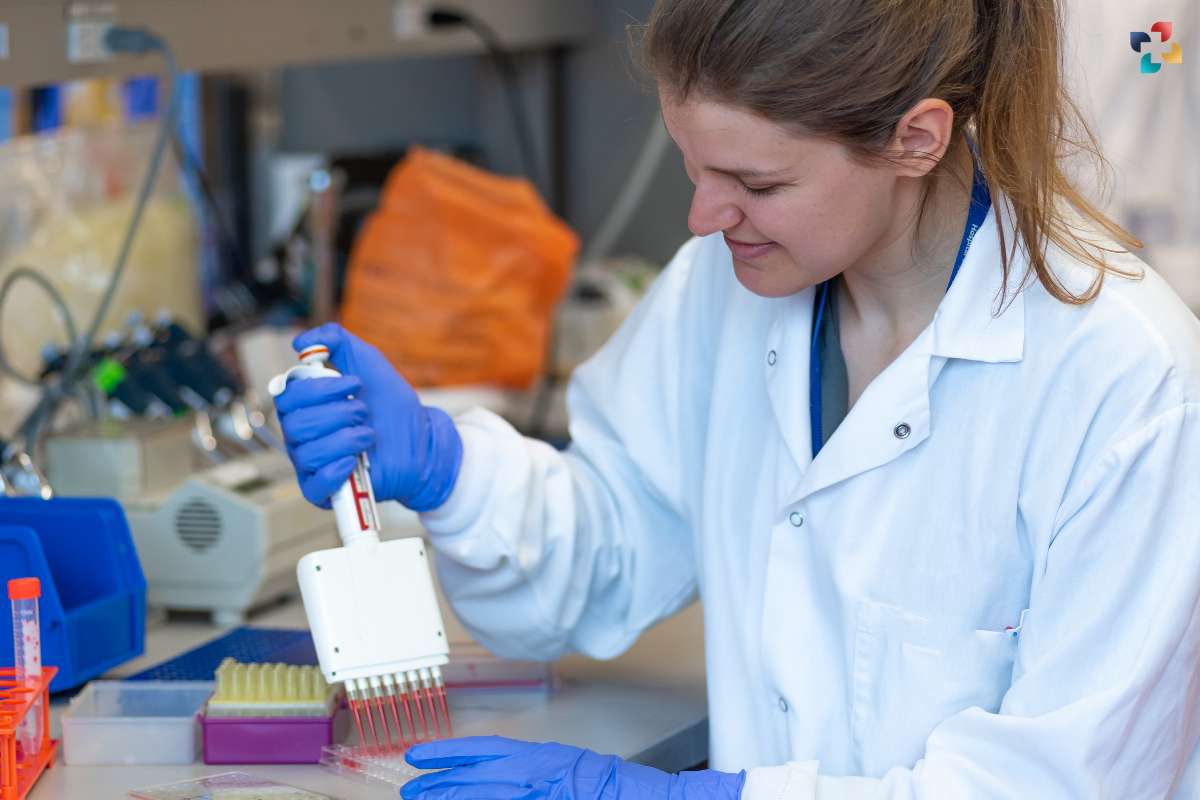Flow cytometry provides unmatched insights into the properties and functions of cells, revolutionizing the fields of clinical diagnosis and biological research. This robust method makes it possible to analyze several factors simultaneously at the single-cell level, giving scientists and medical professionals vital knowledge on cell populations. We shall examine the foundations, uses, and advantages of FC in this piece, highlighting its importance across a range of scientific and medical fields.
Understanding Flow Cytometry:
Flow cytometry is a sophisticated analytical technique that utilizes lasers and fluorescently labeled antibodies to analyze the physical and chemical properties of cells as they flow through a fluidic system. By measuring light scatter and fluorescence emitted by individual cells, flow cytometers can quantify various cellular parameters, including cell size, granularity, morphology, and protein expression levels. This enables researchers to characterize and isolate specific cell populations based on their unique characteristics, facilitating a wide range of biological and clinical studies.
Applications of Flow Cytometry:
Flow cytometry has diverse applications across multiple fields, including immunology, hematology, oncology, microbiology, and stem cell research. In immunology, FC is commonly used to analyze immune cell subsets, assess cell proliferation and apoptosis, and measure cytokine production. In hematology, FC plays a crucial role in diagnosing and monitoring hematological malignancies, such as leukemia and lymphoma, by identifying abnormal cell populations and detecting aberrant antigen expression patterns.

Moreover, flow cytometry is instrumental in cancer research, enabling the characterization of tumor cells, the assessment of drug responses, and the monitoring of minimal residual disease. In microbiology, FC facilitates the rapid detection and quantification of microbial populations, including bacteria, viruses, and fungi, offering valuable insights into microbial physiology, pathogenesis, and antimicrobial resistance.
In stem cell research, flow cytometry is used to analyze and isolate specific stem cell populations based on surface marker expression, facilitating the study of stem cell biology, differentiation pathways, and regenerative medicine applications. Additionally, FC is employed in drug discovery and development, vaccine development, and quality control processes in biopharmaceutical manufacturing.
- Immunology: FC is utilized to analyze immune cell subsets, assess cell proliferation and apoptosis, and measure cytokine production.
- Hematology: It plays a crucial role in diagnosing and monitoring hematological malignancies by identifying abnormal cell populations and detecting aberrant antigen expression patterns.
- Oncology: FC enables the characterization of tumor cells, assessment of drug responses, and monitoring of minimal residual disease in cancer research.
- Microbiology: It facilitates the rapid detection and quantification of microbial populations, providing insights into microbial physiology, pathogenesis, and antimicrobial resistance.
- Stem Cell Research: Flow cytometry is instrumental in analyzing and isolating specific stem cell populations based on surface marker expression, aiding in the study of stem cell biology and regenerative medicine.
- Drug Discovery and Development: Flow cytometry is employed in drug discovery, vaccine development, and quality control processes in biopharmaceutical manufacturing, offering valuable insights into cellular responses and interactions.
Benefits of Flow Cytometry:
FC offers several advantages over traditional cell analysis methods, including high throughput, multiparametric analysis, and single-cell resolution. By analyzing thousands of cells per second, flow cytometers enable rapid and efficient data acquisition, allowing researchers to generate large datasets quickly. Moreover, the ability to simultaneously measure multiple parameters on a cell-by-cell basis provides comprehensive insights into cellular heterogeneity and functional diversity within complex populations.

Furthermore, flow cytometry offers excellent sensitivity and specificity, allowing researchers to detect rare cell populations and quantify subtle changes in cellular properties with high precision. This makes flow cytometry an invaluable tool for studying rare cell subsets, such as circulating tumor cells, stem cells, and immune cell subpopulations, which play critical roles in various physiological and pathological processes.
Moreover, FC is highly versatile and adaptable, with applications ranging from basic research to clinical diagnostics. Its flexibility allows researchers to customize experimental protocols and design sophisticated assays to address specific research questions or clinical needs. Additionally, FC is compatible with a wide range of sample types, including blood, bone marrow, tissue homogenates, and cell cultures, making it suitable for studying diverse biological systems and disease models.
- High Throughput: Flow cytometry enables rapid and efficient data acquisition by analyzing thousands of cells per second, allowing for the generation of large datasets quickly.
- Multiparametric Analysis: The ability to simultaneously measure multiple parameters on a cell-by-cell basis provides comprehensive insights into cellular heterogeneity and functional diversity within complex populations.
- Single-Cell Resolution: FC offers single-cell resolution, allowing researchers to analyze individual cells within a population and identify rare cell subsets with high precision.
- Sensitivity and Specificity: It provides excellent sensitivity and specificity, enabling the detection of rare cell populations and the quantification of subtle changes in cellular properties with high precision.
- Versatility: FC is highly versatile and adaptable, with applications ranging from basic research to clinical diagnostics, and it is compatible with a wide range of sample types, making it suitable for studying diverse biological systems and disease models.

FAQs:
1. What is the principle behind flow cytometry?
Flow cytometry relies on lasers and fluorescently labeled antibodies to analyze cellular properties and functions at the single-cell level.
What are the main applications of FC in biomedical research? FC is widely used in immunology, hematology, oncology, microbiology, stem cell research, drug discovery, and biopharmaceutical manufacturing.
2. How does flow cytometry facilitate cancer research?
FC enables the characterization of tumor cells, assessment of drug responses, monitoring of minimal residual disease, and identification of cancer stem cell populations.
3. What are the advantages of flow cytometry over traditional cell analysis methods?
Flow cytometry offers high throughput, multiparametric analysis, single-cell resolution, sensitivity, specificity, versatility, and compatibility with various sample types.
4. How is flow cytometry used in clinical diagnostics?
FC is employed in the diagnosis and monitoring of hematological malignancies, immunodeficiency disorders, infectious diseases, and autoimmune disorders, among others.
Conclusion:
Flow cytometry is a potent and adaptable analytical method that has revolutionized clinical diagnostics and biomedical research. FC has transformed our knowledge of intricate biological processes and disease pathways by offering in-depth insights into cellular properties and functions.
FC is still a driving force behind innovation and discovery in a wide range of scientific and medical domains, from immunology and oncology to microbiology and stem cell research. The influence of FC on biomedical research and healthcare is expected to grow as new applications and technological advancements arise, providing fresh chances for clinical translation and scientific investigation.











